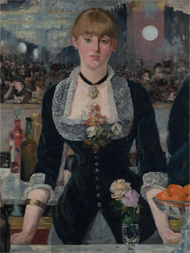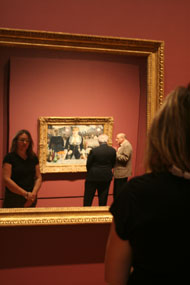 |

 |
 |
A Bar at the Folies-Bergère (detail), Édouard Manet, 1882
The Samuel Courtauld Trust, Courtauld Institute of Art Gallery, London
|
 |
 |
|
French painter Édouard Manet presented A Bar at the Folies-Bergère at the 1882 Paris Salon exhibition just one year before his death. The painting is the culmination of his interest in scenes of urban leisure and spectacle, a subject that he had developed in dialogue with Impressionism over the previous decade. On loan from the Courtauld Institute of Art Gallery in London, the painting is a masterpiece that has perplexed and inspired artists and scholars since it was painted over 100 years ago. The Folies-Bergère was one of the most elaborate variety-show venues in Paris, showcasing entertainment ranging from ballets to circus acts. Another attraction was the barmaids, who were assumed by many contemporary observers to be available as clandestine prostitutes. By depicting one of these women and her male customer on an imposing scale, Manet brazenly introduced a morally suspect, contemporary subject into the realm of high art. By treating the topic with deadpan seriousness and painterly brilliance, Manet staked his claim to be remembered as the heroic "painter of modern life" envisaged by critics like Charles Baudelaire.
|

 |
 |
A Bar at the Folies-Bergère, Édouard Manet, 1882
|
 |
 |
|
|
 |
In addition to the social tensions evoked by the painting's subject, Manet's composition presents a visual puzzle. The barmaid looks directly at the viewer, while the mirror behind her reflects the large hall and patrons of the Folies-Bergère. Manet seems to have painted the image from a viewpoint directly opposite the barmaid. Yet this viewpoint is contradicted by the reflection of the objects on the bar and the figures of the barmaid and a patron off to the right. Given such inconsistencies, Manet seems not to have offered a single, determinate position from which to confidently make sense of the whole.
|
 |

 |
 |
In the installation at the Getty Center, a mirror has been installed to help dramatize the questions of vision and reflection raised by Manet's painting.
|
 |
The visual and psychological ambiguities of A Bar at the Folies-Bergère have prompted many questions:
• How are we to characterize the barmaid's expression?
• What is the nature of the viewer's relationship to the barmaid?
• What is happening between the barmaid and the man reflected in the mirror?
• If we see the man's reflection in the mirror, why isn't his figure also visible in front of the bar?
• Why is there no indication in the mirror of the balcony walkway on which we imagine the man, or ourselves, to be standing?
• Why are the reflections of the figures and still life objects displaced so far to the right?
The more one reflects on Manet's painting, the more difficult it becomes to project a straightforward narrative onto it, and the more conscious and uncertain we become of our position as spectators. At once invoking and undermining the traditional notion of painting-as-mirror, Manet's work becomes a profound interrogation of the act of looking itself.
What's Your Reaction to the Painting?
What do you make of the painting's visual and psychological ambiguities?
|


